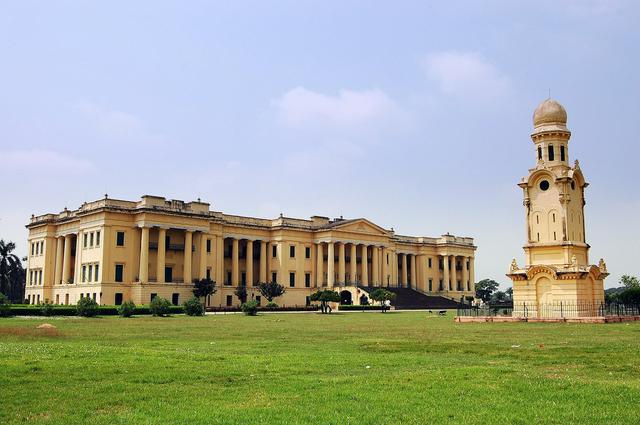 Murshidabad is a town and district in West Bengal. It was once the capital of Bangla, Bihar and Odisha. The last capital city of independent Bengal was named after Nawab Murshid Quli Khan, the Dewan of Bengal, Bihar and Odisha. It is situated on the banks of the Bhagirathi. A city of splendors and famous for its silk, it was made capital of Bengal in 1717. The British shifted the capital to Kolkata in 1773.
Murshidabad is a town and district in West Bengal. It was once the capital of Bangla, Bihar and Odisha. The last capital city of independent Bengal was named after Nawab Murshid Quli Khan, the Dewan of Bengal, Bihar and Odisha. It is situated on the banks of the Bhagirathi. A city of splendors and famous for its silk, it was made capital of Bengal in 1717. The British shifted the capital to Kolkata in 1773.
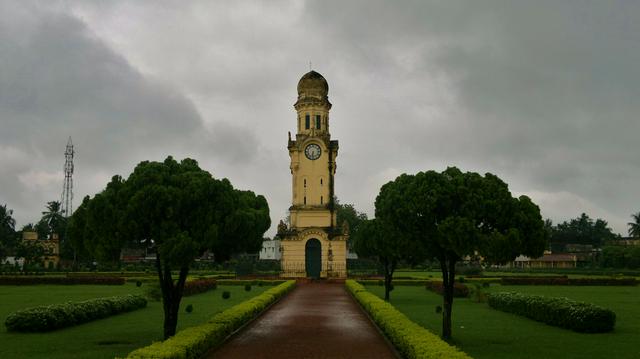
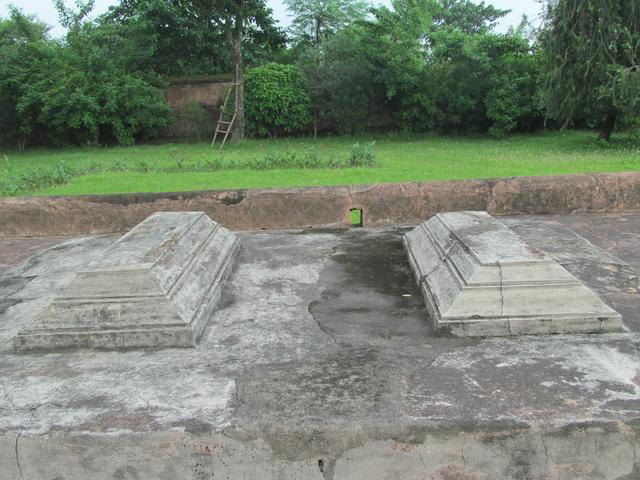
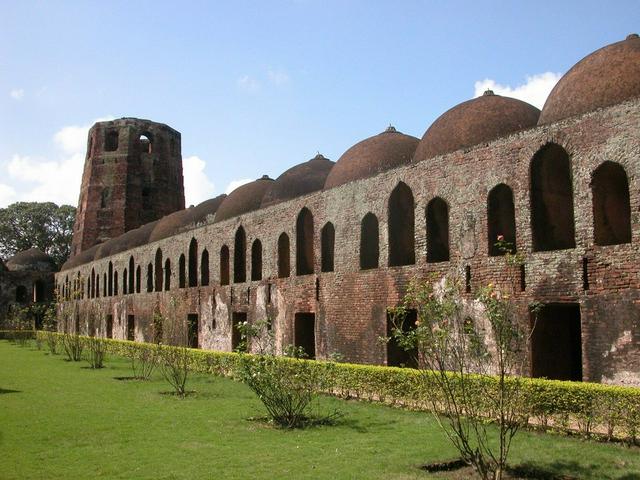
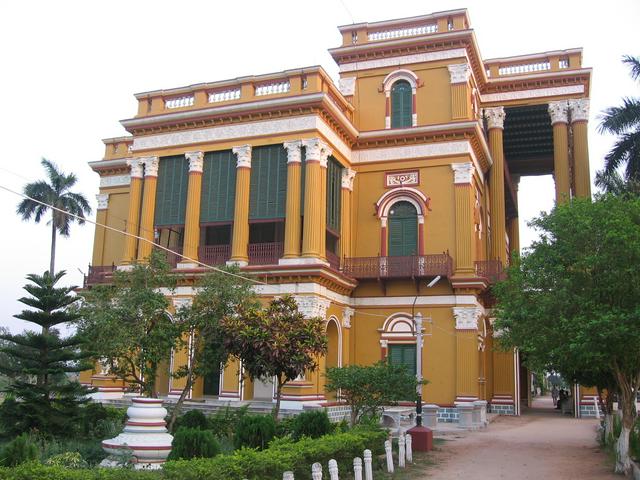
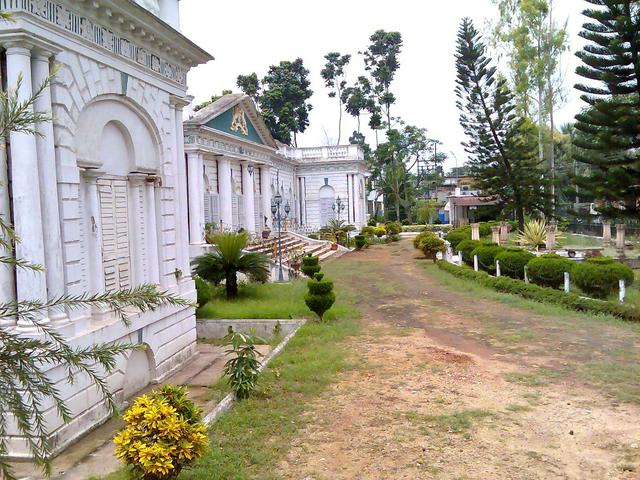 The historical sites of Murshidabad can be divided into 5 sectors:
The historical sites of Murshidabad can be divided into 5 sectors:
- Hazarduari Complex
- East of Hazarduari Complex
- North of of Hazarduari Complex
- South of Hazarduari Complex
- Cossimbazar
- West of Bhagirati River
- Azimganj
- Hazar Duari Palace. 9AM - 5PM. A palace of 1000 doors - real and fake. The palace was constructed by Duncan Macleod in 1837 on the orders of Nawab Nazim Humayun Jah at the site of the old fort known as Nizamat Quila. It has a typicaI European style of architecture. This has now been converted into a museum. The Hazarduari Palace Museum is regarded as the biggest site museum of Archaeological Survey of India and has got 20 displayed galleries containing 4742 antiquities out of which 1034 has been displayed for the public. The antiquities include various weapons, oil paintings of Dutch, French and Italian artists, marble statues, metal objects, porcelain and stucco statues, farmans, rare books, old maps, manuscripts, land revenue records and palanquins mostly belonging to eighteenth and nineteenth centuries.
- Bara Imambara. The imambara is a congregation hall for Shia commemoration ceremonies, especially those associated with the remembrance of Muharram. It is situated just opposite the palace. Both are on the banks of the river Bhagirathi. It was built in 1847 by Nawab Nazim Mansoor Ali Khan Feradun Jah, at the site of the old wooden imambara built earlier by Siraj-ud-daulah and damaged by fire. The present Imambara is 680 feet long. It is divided into three large quadrangles: the central quadrangle has the Madina Mosque and the Memberdalan; the eastern quadrangle has the Nowbat Khana; the western quadrangle has a two-storied mosque.
- Clock Tower. There is a Clock Tower between Hazarduari and Imambara. It was built by Sagar Mistri, assistant of Duncan Macleod. At the top of he tower is a big heavy sounding bell.
- Madina Masjid. The old Madina Mosque built by Siraj-ud-daulah is in front of the Imambara. A new Madina Mosque was built as a part of the Imambara.
- Bachchawali Topp. Located between Hazarduri and Imambara is the Bachchawali Topp. The barrel is 11′6″ long, with a girth in the middle of 7′9″. Made between 12th and 14th centuries, it weighs 7657 kg. Look out for brass inlay lines and designs on the cannon
- Zurud Masjid. Zurad Masjid or the Yellow Mosque is located a few yards from the Hazarduari Palace and is on the banks of the River Bhagirati. It was built by Siraj - ud - Daula. It has three domes and is yellow in colour.
Hazar Duari Palace. 9AM - 5PM. A palace of 1000 doors - real and fake. The palace was constructed by Duncan Macleod in 1837 on the orders of Nawab Nazim Humayun Jah at the site of the old fort known as Nizamat Quila. It has a typicaI European style of architecture. This has now been converted into a museum. The Hazarduari Palace Museum is regarded as the biggest site museum of Archaeological Survey of India and has got 20 displayed galleries containing 4742 antiquities out of which 1034 has been displayed for the public. The antiquities include various weapons, oil paintings of Dutch, French and Italian artists, marble statues, metal objects, porcelain and stucco statues, farmans, rare books, old maps, manuscripts, land revenue records and palanquins mostly belonging to eighteenth and nineteenth centuries.
Bara Imambara. The imambara is a congregation hall for Shia commemoration ceremonies, especially those associated with the remembrance of Muharram. It is situated just opposite the palace. Both are on the banks of the river Bhagirathi. It was built in 1847 by Nawab Nazim Mansoor Ali Khan Feradun Jah, at the site of the old wooden imambara built earlier by Siraj-ud-daulah and damaged by fire. The present Imambara is 680 feet long. It is divided into three large quadrangles: the central quadrangle has the Madina Mosque and the Memberdalan; the eastern quadrangle has the Nowbat Khana; the western quadrangle has a two-storied mosque.
Clock Tower. There is a Clock Tower between Hazarduari and Imambara. It was built by Sagar Mistri, assistant of Duncan Macleod. At the top of he tower is a big heavy sounding bell.
Madina Masjid. The old Madina Mosque built by Siraj-ud-daulah is in front of the Imambara. A new Madina Mosque was built as a part of the Imambara.
Bachchawali Topp. Located between Hazarduri and Imambara is the Bachchawali Topp. The barrel is 11′6″ long, with a girth in the middle of 7′9″. Made between 12th and 14th centuries, it weighs 7657 kg. Look out for brass inlay lines and designs on the cannon
Zurud Masjid. Zurad Masjid or the Yellow Mosque is located a few yards from the Hazarduari Palace and is on the banks of the River Bhagirati. It was built by Siraj - ud - Daula. It has three domes and is yellow in colour.
- Katra Masjid. Built by Nawab Murshid Quli Khan in 1723 AD. It is damaged but well maintained. The main mosque had five domes, out of which two collapsed in the earthquake of 1897. Many of the buildings in and around the mosque also collapsed during the earthquake. 2000 people could offer prayers in the mosque at the same time.
- Fouti Masjid. Fouti Masjid is an abandoned mosque, only two of its five domes were completed. It was constructed by Sarfaraz Khan in 1740. After the defeat and death of Sarfaraz Khan the construction was abandoned and ever since then the mosque lies in that same state. It is 135 feet long and 38 feet broad. Centre of the western wall houses a triple mihrab.
- Jahan Kosha Cannon. The Topekhana was to the south-east of the Katra Masjid. There still is a huge cannon names Jahan Kosha (Destroyer of the world).The canon is said to have been brought from Dhaka when Mushid Quli Khan shifted his capital.
Katra Masjid. Built by Nawab Murshid Quli Khan in 1723 AD. It is damaged but well maintained. The main mosque had five domes, out of which two collapsed in the earthquake of 1897. Many of the buildings in and around the mosque also collapsed during the earthquake. 2000 people could offer prayers in the mosque at the same time.
Fouti Masjid. Fouti Masjid is an abandoned mosque, only two of its five domes were completed. It was constructed by Sarfaraz Khan in 1740. After the defeat and death of Sarfaraz Khan the construction was abandoned and ever since then the mosque lies in that same state. It is 135 feet long and 38 feet broad. Centre of the western wall houses a triple mihrab.
Jahan Kosha Cannon. The Topekhana was to the south-east of the Katra Masjid. There still is a huge cannon names Jahan Kosha (Destroyer of the world).The canon is said to have been brought from [[Dhaka]] when Mushid Quli Khan shifted his capital.
- Tomb Of Azimunnisa Begum. Azimunnisa Begum, was the daughter of Murshid Quli Khan. According to legend she was diagnosed with a incurable disease. To get cured she was advised to eat the liver of infants. She got addicted to it and continued the practice. Ultimately it came to the attention of her father and he had her buried alive. There are several versions of the story. She was buried under a mosque and only a small portion of the mosque wall stands to this day.
- Jafarganj Cemetery. About half a mile from the Hazarduari Palace is Jafarganj the ruined palace of Mir Jafar. The Cemetery contains the tombs of the Nawab's Nazim, from Mir Jafar to Humayun Jah. Mir Jafar's father Syud Ahmed Nazafi, Alivardi Khan's sister, Shahkhanum, Mir Jafar's widows, Munni Begam and Babbu Begam, Mohamed Ali Khan, the brother and Ismail Ali Khan and Asraf Ali Khan, the sons-in-law of Mir Jafar, lie buried here. This cemetery was built by Mir Jafar, over an area of 3.51 acres and houses about 1100 graves.
- Nimak Haram Deuri. Nimak Haram Deuri is the gateway to Mir Jafar's palace. The palace lo longer exist but it entrance gate still stands.
- Nasipur Palace and Laxmi Narayan Mondir. The palace was built by King Kirtichand Bahadur in 1865. Within the palace compound are temples: the Ramachandra temple and the Lakshmi-Narayana temple. Closely situated is the Ashram of Mohandas and Jafraganj Deuri. The two cannons present here are said to be gifted to Mir Jafar by Clive.
- House of Jagat Seth and Pareshnath Temple. Jagat Seths were a a business family and were involved in the business of banking and money lending. His house has been restored and converted into a museum. The complex also houses a Jain Temple dedicated to the 23rd Jain Tirthankar Parshanath
- Kathgola. The palace garden of Raja Dhanpat Singh Dugar and Lakshmipat Singh Dugar and their famous Adinath Digamber Jain Mandir. were built in 1873, by Harreck Chand. The walls of this temple are also intricately designed. A typically Jain style of ornamentation lends a unique beauty to this Jain temple. It is about half a km South-East of Mahimapur. Though some of its glory has been lost, it still remains a major tourist attraction, chiefly because of the beautiful temple with an admirable work of stucco. The complex also houses a small zoo and a statue by the famous sculptor Michelangelo.
Tomb Of Azimunnisa Begum. Azimunnisa Begum, was the daughter of Murshid Quli Khan. According to legend she was diagnosed with a incurable disease. To get cured she was advised to eat the liver of infants. She got addicted to it and continued the practice. Ultimately it came to the attention of her father and he had her buried alive. There are several versions of the story. She was buried under a mosque and only a small portion of the mosque wall stands to this day.
Jafarganj Cemetery. About half a mile from the Hazarduari Palace is Jafarganj the ruined palace of Mir Jafar. The Cemetery contains the tombs of the Nawab's Nazim, from Mir Jafar to Humayun Jah. Mir Jafar's father Syud Ahmed Nazafi, Alivardi Khan's sister, Shahkhanum, Mir Jafar's widows, Munni Begam and Babbu Begam, Mohamed Ali Khan, the brother and Ismail Ali Khan and Asraf Ali Khan, the sons-in-law of Mir Jafar, lie buried here. This cemetery was built by Mir Jafar, over an area of 3.51 acres and houses about 1100 graves.
Nimak Haram Deuri. Nimak Haram Deuri is the gateway to Mir Jafar's palace. The palace lo longer exist but it entrance gate still stands.
Nasipur Palace and Laxmi Narayan Mondir. The palace was built by King Kirtichand Bahadur in 1865. Within the palace compound are temples: the Ramachandra temple and the Lakshmi-Narayana temple. Closely situated is the Ashram of Mohandas and Jafraganj Deuri. The two cannons present here are said to be gifted to Mir Jafar by Clive.
House of Jagat Seth and Pareshnath Temple. Jagat Seths were a a business family and were involved in the business of banking and money lending. His house has been restored and converted into a museum. The complex also houses a Jain Temple dedicated to the 23rd Jain Tirthankar Parshanath
Kathgola. The palace garden of Raja Dhanpat Singh Dugar and Lakshmipat Singh Dugar and their famous Adinath Digamber Jain Mandir. were built in 1873, by Harreck Chand. The walls of this temple are also intricately designed. A typically Jain style of ornamentation lends a unique beauty to this Jain temple. It is about half a km South-East of Mahimapur. Though some of its glory has been lost, it still remains a major tourist attraction, chiefly because of the beautiful temple with an admirable work of stucco. The complex also houses a small zoo and a statue by the famous sculptor Michelangelo.
- Tripolia Gate. The triple arched gate is topped with a nahabatkhana. The arches are high enough to let elephant pass. It is built by Nawab Shuja Uddin Khan who succeeded Murshid Quli Khan.
- Chawk Masjid. The Chawk Mosque was built in 1767 by Munni Begum wife of Mir Jafar. The mosque has five domes and approached through an entrance flanked with minerates
- Wasif Ali Manzil. The original palace was destroyed in an earthquake. The present palace is built by Nawab Wasif Ali Mirza Khan, the Nawab of Murshidabad. It has been beautifully restored. Sadly entry into the palace is restricted.
- Begum Mahal of Wasif Manzil. Behind the Wasif Manzil lies the ruins of Begum Mahal of Wasif Manzil. It is in total ruins
- Safed Masjid. The white coloured Safed Mosque was built by Siraj ud Daulah in 1756 - 57. The three domed mosque lies on the banks of Bhagirati and is near the Dakshin Darwaza (South Gate)
- Ghari Ghanta. Located just north of the Dakshin Darwaza, the Ghari Ghanta consists of a bell on top of a bastion.
- Dakshin Darja. The southern entrance of Quila Nizamat. The single arche entrance is surmounted by a Nawbat Khana where royal instruments were played. The entrance is large & high enough for an elephant to pass with howdah on its back.. It was built by Nawab Ahmad Ali Khan.
- Moti jheel. This beautiful horseshoe shaped lake was excavated by Nawazesh Mohammad, the husband of the famous Ghasseti Begum. In the palace adjoining it (now in ruins) Lord Clive celebrated the acquisition of the Dewani of Sube Bangla (Bengal, Bihar & Odisha) in 1765. Moti Jheel was the home of Warren Hastings when he became the Political President at the Durbar of the Nawab Nazim ( 1771 - 73 AD ). Sir John Shore, afterwards Lord Teinmouth, also lived here. Moti Jheel is also known as the "Company Bagh", due to the fact of it having been in the occupation of the East India Company. The only old building existing is the Motijheel Masjid.
Tripolia Gate. The triple arched gate is topped with a nahabatkhana. The arches are high enough to let elephant pass. It is built by Nawab Shuja Uddin Khan who succeeded Murshid Quli Khan.
Chawk Masjid. The Chawk Mosque was built in 1767 by Munni Begum wife of Mir Jafar. The mosque has five domes and approached through an entrance flanked with minerates
Wasif Ali Manzil. The original palace was destroyed in an earthquake. The present palace is built by Nawab Wasif Ali Mirza Khan, the Nawab of Murshidabad. It has been beautifully restored. Sadly entry into the palace is restricted.
Begum Mahal of Wasif Manzil. Behind the Wasif Manzil lies the ruins of Begum Mahal of Wasif Manzil. It is in total ruins
Safed Masjid. The white coloured Safed Mosque was built by Siraj ud Daulah in 1756 - 57. The three domed mosque lies on the banks of Bhagirati and is near the Dakshin Darwaza (South Gate)
Ghari Ghanta. Located just north of the Dakshin Darwaza, the Ghari Ghanta consists of a bell on top of a bastion.
Dakshin Darja. The southern entrance of Quila Nizamat. The single arche entrance is surmounted by a Nawbat Khana where royal instruments were played. The entrance is large & high enough for an elephant to pass with howdah on its back.. It was built by Nawab Ahmad Ali Khan.
Moti jheel. This beautiful horseshoe shaped lake was excavated by Nawazesh Mohammad, the husband of the famous Ghasseti Begum. In the palace adjoining it (now in ruins) Lord Clive celebrated the acquisition of the Dewani of Sube Bangla (Bengal, Bihar & Odisha) in 1765. Moti Jheel was the home of Warren Hastings when he became the Political President at the Durbar of the Nawab Nazim ( 1771 - 73 AD ). Sir John Shore, afterwards Lord Teinmouth, also lived here. Moti Jheel is also known as the "Company Bagh", due to the fact of it having been in the occupation of the East India Company. The only old building existing is the Motijheel Masjid.
- Cossimbazar Palace of the Roys. Cossimbazar was a flourishing river port during the hay days of Murshidabad. The Roys who settled Cossimbazar made a fortune by trading in silk. Cossimbazar Palace of the Roys or the Cossimbazar Choto Rajbari has been converted into a heritage hotel.
- Cossimbazar Palace. This lies next to the Cossimbazar Palace of the Roys and is much larger in size but totally in ruins
- Dutch Cemetery. The Dutch Cemetery of Cassimbazar dates back to the earlu 18th century. The oldest grave is of Daniel Van der Muyl who died in 1721. The cemetery has 47 tombs most of them obelisk. The cemetery contains a temple like unknown tomb.
- British Cemetery. This British Cemetery contains several tombs and graves including the tomb of Mary Hastings, wife of Warren Hastings and that of her daughter.
- Armenian Church of St. Mary's. The St. Mary Armenian Church of Saidabad, near Baharampur, was constructed in 1758 by Khoja Petros Arathoon. The church closed down after its last sermon in 1860 and was reopened in 2005.
Cossimbazar Palace of the Roys. Cossimbazar was a flourishing river port during the hay days of Murshidabad. The Roys who settled Cossimbazar made a fortune by trading in silk. Cossimbazar Palace of the Roys or the Cossimbazar Choto Rajbari has been converted into a heritage hotel.
Cossimbazar Palace. This lies next to the Cossimbazar Palace of the Roys and is much larger in size but totally in ruins
Dutch Cemetery. The Dutch Cemetery of Cassimbazar dates back to the earlu 18th century. The oldest grave is of Daniel Van der Muyl who died in 1721. The cemetery has 47 tombs most of them obelisk. The cemetery contains a temple like unknown tomb.
British Cemetery. This British Cemetery contains several tombs and graves including the tomb of Mary Hastings, wife of Warren Hastings and that of her daughter.
Armenian Church of St. Mary's. The St. Mary Armenian Church of Saidabad, near Baharampur, was constructed in 1758 by Khoja Petros Arathoon. The church closed down after its last sermon in 1860 and was reopened in 2005.
- Khosbag. Cemetery of Alivardi Khan, his grandson Siraj-ud-daulah and other members of the family
- Rosnaiganj Garden. Houses the Tomb of Nawab Shuja Uddin Khan, son in law and successor of Murshid Quli Khan.
Khosbag. Cemetery of Alivardi Khan, his grandson Siraj-ud-daulah and other members of the family
Rosnaiganj Garden. Houses the Tomb of Nawab Shuja Uddin Khan, son in law and successor of Murshid Quli Khan.
- Char Bangla Temple. The temple complex houses four temples of do chala or Bangla style of architecture, hence the name Char Bangla. The outer walls of the all the four temples are decorated with intricate terracotta ornamentation. The temples were constructed by Rani Bhabani of Nator in 18th century.
- Gangeswar Temple. Located just north of the Char Bangla Complex the Gangeswar Temple follows the Jor Bangla style of architecture and also has rich terracotta ornamentation.
- Bhabaniswar Mandir. This octagonal temple lacks terracotta ornamentation but it is largely compensated by beautiful stucco work, It was built by Tarasundari (daughter of Rani Bhabani) in 1755.
Char Bangla Temple. The temple complex houses four temples of do chala or Bangla style of architecture, hence the name Char Bangla. The outer walls of the all the four temples are decorated with intricate terracotta ornamentation. The temples were constructed by Rani Bhabani of Nator in 18th century.
Gangeswar Temple. Located just north of the Char Bangla Complex the Gangeswar Temple follows the Jor Bangla style of architecture and also has rich terracotta ornamentation.
Bhabaniswar Mandir. This octagonal temple lacks terracotta ornamentation but it is largely compensated by beautiful stucco work, It was built by Tarasundari (daughter of Rani Bhabani) in 1755.
- Baluchari Sarees. These are figured silk sarees produced in the town of Baluchar in Murshidabad district. Baluchar sarees essentially have a silk base with silk brocaded designs with respect to their colours, where in spite of a rich composition, the Baluchar bootidars almost avoid strong contrasts. Each pattern is treated in a colour which harmonises with the ground on which it is laid. The most popular colours used are red, blue, yellow, green and scarlet. The Baluchari sarees have large floral motifs interspersed with flowering shrubs. Traditionally the Muslim community was also known to produce these Baluchars with figured patterns depicting court scenes, horse with a rider, women smoking hookah. The Kalka design or the cone motif is often surrounded with floral borders.
- Murshidabad Silk. Most Baluchar artisans have long migrated to Bishnupur. Hence Murshidabad is no more famous for Baluchari Saree. Rather one can purchase Murshidabad Silk Kora Saree than particularly for different types of embroidery works in Kolkata. These things are available in most Khadi shops in Berhampore and Khagra. But purchase it if they provide a rebate of 20% on its printed price. Most of them give it throughout the year even when Govt subsidy is not available.
- Other things include Shola art, brass, copper and Kansha items.
Baluchari Sarees. These are figured silk sarees produced in the town of Baluchar in Murshidabad district. Baluchar sarees essentially have a silk base with silk brocaded designs with respect to their colours, where in spite of a rich composition, the Baluchar bootidars almost avoid strong contrasts. Each pattern is treated in a colour which harmonises with the ground on which it is laid. The most popular colours used are red, blue, yellow, green and scarlet. The Baluchari sarees have large floral motifs interspersed with flowering shrubs. Traditionally the Muslim community was also known to produce these Baluchars with figured patterns depicting court scenes, horse with a rider, women smoking hookah. The Kalka design or the cone motif is often surrounded with floral borders.
Murshidabad Silk. Most Baluchar artisans have long migrated to Bishnupur. Hence Murshidabad is no more famous for Baluchari Saree. Rather one can purchase Murshidabad Silk Kora Saree than particularly for different types of embroidery works in Kolkata. These things are available in most Khadi shops in Berhampore and Khagra. But purchase it if they provide a rebate of 20% on its printed price. Most of them give it throughout the year even when Govt subsidy is not available.
Nothing special in Murshidabad particularly for Kolkatans. Nawabi Ghee-e bhaja chhanabora has been replaced by Dalda-bhaja one. Still Kolkatans can relish sweets and curd of Murshidabad because those are much cheaper here.
If you sit for lunch in a roadside ordinary hotel near Hazarduary, first ask whether the menu follows meal-system or a la carte and the rate. Otherwise, you may feel cheated after the lunch is over.
The ground water here is contaminated with arsenic, so you are better off drinking from the municipal supply of surface water or bottled drinking water of reputed companies, not of ordinary companies, here and there in Murshidabad district, even if those are cheaper by ₹2 per litre.
- Baharampur
- Malda City
- Raiganj
- Bethuadahari
- Krishnanagar
